Thomas Graves, 1st Baron Graves
Thomas Graves, 1st Baron Graves | |
|---|---|
 Portrait of Graves by Thomas Gainsborough | |
| Born | 23 October 1725 |
| Died | 9 February 1802 (aged 76) |
| Allegiance | |
| Service/ | |
| Rank | Admiral |
| Commands held | North American Station Plymouth Command |
| Battles/wars | Seven Years' War American War of Independence French Revolutionary Wars |
Thomas Graves, 1st Baron Graves KB (23 October 1725 – 9 February 1802) was a British Admiral of the Royal Navy and colonial official. He served in the Seven Years' War and the American War of Independence. He was also the Commodore-Governor of Newfoundland for a period of time.[1]
Graves was the second son of Rear-Admiral Thomas Graves of Thanckes in Cornwall.[2]
In the first year of the Seven Years' War, Graves failed to confront a French ship which gave challenge.[1] He was tried by court-martial for not engaging his ship, and reprimanded.[1] Graves became Commodore-Governor of Newfoundland in 1761[1] and given the duty of convoying the seasonal fishing fleet from England to the island. In 1762 he learned that French ships had captured St. John's. Graves, Admiral Alexander Colville and Colonel William Amherst retook the port city.[1]
With the end of the Seven Years' War, Labrador came under his responsibility as French fishing fleets returned to the French Shore and St. Pierre and Miquelon. Graves strictly enforced the treaties to the extent that the French government protested. Graves' governorship ended in 1764. He returned to active service during the American War of Independence and became commander-in-chief of the North American Squadron in 1781.[1] when Mariot Arbuthnot returned home.
During the American War of Independence, his fleet was defeated by the Comte de Grasse in the Battle of the Chesapeake at the mouth of Chesapeake Bay on 5 September 1781, leading to the surrender of Lord Cornwallis at Yorktown.
In September 1782, a fleet under his command was caught in a violent storm off the banks of Newfoundland. The captured French ships from the Battle of the Saintes Ville de Paris (110 guns) and HMS Glorieux (74 guns), and the British ships HMS Ramillies (74 guns) and HMS Centaur (74 guns) foundered, along with other merchant ships, with the loss of 3,500 lives. In 1786 Graves became Commander-in-Chief, Plymouth.[1][3]
With the French Revolutionary Wars, Graves was second in command to Admiral Richard Howe at the British victory over the French at the Battle of the Glorious First of June 1794. Graves became a full admiral and was awarded an Irish peerage as Baron Graves, of Gravesend in the County of Londonderry.[4]
He died in February 1802, aged 76, and was succeeded in the barony by his son Thomas.
Family
Lord Graves married Elizabeth, daughter of William Peere Williams, in 1771.
Arms
  |
|
See also
Notes
- ^ a b c d e f g Article by Kenneth Breen, ‘Graves, Thomas, first Baron Graves (1725–1802)’, Oxford Dictionary of National Biography, Oxford University Press, Sept 2004; online edn, Jan 2008; accessed 4 June 2008.
- ^ Historic Cornwall website: Thanckes estate near Torpoint.
- ^ "Admiral Graves, we hear, will succeed Admiral Milbanke in the Station of Port Admiral at Plymouth". The Public Advertiser. 22 February 1786. p. 2. Retrieved 2 January 2014.
- ^ London Gazette no. 13727. p. 1178
- ^ Burke's Peerage. 1949.
References
- Kidd, Charles, Williamson, David (editors). Debrett's Peerage and Baronetage (1990 edition). New York: St Martin's Press, 1990, [page needed]
- Leigh Rayment's Peerage Pages [self-published source] [better source needed]
External links
- Biography at Government House The Governorship of Newfoundland and Labrador
- "Thomas Graves, 1st Baron Graves". Dictionary of Canadian Biography (online ed.). University of Toronto Press. 1979–2016.
- Use dmy dates from April 2012
- 1725 births
- 1802 deaths
- Royal Navy personnel of the American Revolutionary War
- Governors of Newfoundland Colony
- Barons in the Peerage of Ireland
- Peers of Ireland created by George III
- Royal Navy admirals
- Knights Companion of the Order of the Bath
- Members of the Parliament of Great Britain for constituencies in Cornwall
- British MPs 1774–1780
